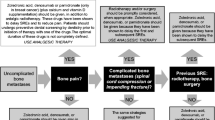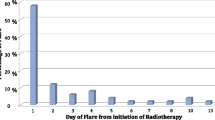Abstract
Background
In patients with bone metastases, pain may be absent or moderate at rest, but may be exacerbated by different movements or positions. No study has evaluated separately pain at rest and on movement in patients with bone metastases undergoing treatment with zoledronic acid (ZA).
Aim
The aim of this prospective observational study was to evaluate the reduction in intensity of pain at rest and in movement-related pain after treatment with up to six infusions of ZA 4 mg every 28 days in patients with painful bone metastases due to breast or prostate cancer cared for at the Oncological Units and Pain Therapy and Palliative Care Unit of the NCI of Milano.
Materials and methods
Pain was assessed by a six-level verbal rating scale (0–5 score) at baseline and on each infusion as well as at follow-up visits (2 weeks after every infusion). The two main endpoints (estimated reduction in pain and movement-related pain) were defined as the difference between the baseline score and the average of all the post-treatment scores for each patient. To allow for the potential confounding effect of analgesic consumption, patients without any increase in analgesic consumption during zoledronic acid treatment were also analyzed as a separate subgroup.
Results
Forty-eight patients with breast (34) or prostate cancer (14) were enrolled. At baseline, 100% of the patients had pain on movement, in 65% of them, the intensity ranged from moderate to very severe, in 61% of the patients, the intensity of pain on movement was higher than the intensity of pain at rest (average difference 0.89; 95% CI, 0.5–1.30). The estimated mean intensity reduction of pain at rest and on movement was: (a) 0.62 (95% CI, 0.28–0.98) and 0.79 (95% CI, 0.43–1.14), respectively, during the first 90 days of ZA treatment; (b) 0.59 (95% CI, 0.23–0.96) and 0.86 (95% CI, 0.49–1.23), respectively, during the entire treatment and follow-up period. Analgesic consumption decreased or was stable on average in 31 and 27%, respectively, of available follow-up data. In the 14 patients with decreased or stable analgesic consumption, pain reduction was 0.61 and 1.01, respectively.
Conclusions
In this study, at baseline, all the patients with painful bone metastases experience movement-related pain, and during zoledronic acid treatment, a decrease for both pain at rest and on movement was obtained.



Similar content being viewed by others
References
Bomanji JB, Britton KE, Clarke SEM (1995) Clinician’s guide to nuclear medicine: oncology. Impact Healthcare, Hatfield
Coleman RE, Rubens RD (1987) The clinical course of bone metastases from breast cancer. Br J Cancer 55:61–66
Mundy GR (2002) Metastasis to bone: causes, consequences and therapeutic opportunities. Nat Rev Cancer 2:584–593
Mercadante S, Radbruch L, Caraceni A et al (2002) The steering committee of the European Association for Palliative Care (EAPC). Episodic (breakthrough) pain. Consensus Conference of an Expert Working Group of the EAPC. Cancer 94:832–839
Banning A, Sjogren P, Henriksen H (1991) Treatment outcome in a multidisciplinary cancer pain clinic. Pain 47:129–134
Mercadante S, Maddaloni S, Roccella S et al (1992) Predictive factors in advanced cancer pain treated only by analgesics. Pain 50:151–155
Mercadante S, Armata M, Salvaggio L (1994) Pain characteristics of advanced lung cancer patients referred to a palliative care service. Pain 59:141–145
Bruera E, MacMillan K, Hanson J et al (1989) The Edmonton staging system for cancer pain: preliminary report. Pain 37:203–209
Bruera E, Schoeller T, Wenk R et al (1995) A prospective multicenter assessment of the Edmonton staging system for cancer pain. J Pain Symptom Manage 10:348–355
Kohno N, Aogi K, Minami H et al (2005) Zoledronic acid significantly reduces skeletal complications compared with placebo in Japanese women with bone metastases from breast cancer: a randomized, placebo-controlled trial. J Clin Oncol 23:3314–3321
Nigro C, Donadio M, Ardine M et al (2004) Pain control with zoledronic acid in patients with breast cancer and metastatic bone disease. Am J Cancer 3:257–263
Saad F, Gleason DM, Murray R et al (2004) Long-term efficacy of zoledronic acid for the prevention of skeletal complications in patients with metastatic hormone-refractory prostate cancer. J Natl Cancer Inst 96:879–882
Rosen LS, Gordon D, Kaminski M et al (2003) Long-term efficacy and safety of zoledronic acid compared with pamidronate disodium in the treatment of skeletal complications in patients with advanced multiple myeloma or breast carcinoma: a randomized, double-blind, multicenter, comparative trial. Cancer 98:1735–1744
Wardley A, Davidson N, Barrett-Lee P et al (2005) Zoledronic acid significantly improves pain scores and quality of life in breast cancer patients with bone metastases: a randomised, crossover study of community vs hospital bisphosphonate administration. Br J Cancer 92:1869–1876
Carteni G, Bordonaro R, Giotta F et al (2006) Efficacy and safety of zoledronic acid in patients with breast cancer metastatic to bone: a multicenter clinical trial. Oncologist 11(7):841–848
Eastham J, McKiernan J, Gleason D et al (2005) Effect of zoledronic acid on bone pain and skeletal morbidity in patients with advanced prostate cancer; analysis by baseline pain. Abstract 4561, ASCO Annual Meeting
Wong R, Wiffen PJ (2002) Bisphosphonates for the relief of pain secondary to bone metastases. Cochrane Database of Systematic Reviews, Issue 2. Art. No.: CD002068. DOI 10.1002/14651858.CD002068
Small EJ, Smith MR, Seaman JJ et al (2003) Combined analysis of two multicenter, randomized, placebo-controlled studies of pamidronate disodium for the palliation of bone pain in men with metastatic prostate cancer. J Clin Oncol 21:4277–4284
Groff L, Zecca E, De Conno F et al (2001) The role of disodium pamidronate in the management of bone pain due to malignancy. Palliat Med 15:297–307
Hortobagyi GN, Theriault RL, Porter L et al (1996) Efficacy of pamidronate in reducing skeletal complications in patients with breast cancer and lytic bone metastases. Protocol 19 Aredia Breast Cancer Study Group. N Engl J Med 335:1785–1791
Fulfaro F, Casuccio A, Ticozzi C et al (1998) The role of bisphosphonates in the treatment of painful metastatic bone disease: a review of phase III trials. Pain 78:157–169
Mancini I, Dumon JC, Body JJ (2004) Efficacy and safety of ibandronate in the treatment of opioid-resistant bone pain associated with metastatic bone disease: a pilot study. J Clin Oncol 22:3587–3592
Wellington K, Goa KL (2003) Zoledronic acid: a review of its use in the management of bone metastases and hypercalcemia of malignancy. Drugs 63:417–437
Hillner BE, Ingle JN, Chlebowski RT et al (2003) American society of clinical oncology 2003 update on the role of bisphosphonates and bone health issues in women with breast cancer. J Clin Oncol 21:4042–4057
Ernst DS, Brasher P, Hagen N, Paterson AH, MacDonald RN, Bruera E (1997) A randomized, controlled trial of intravenous clodronate in patients with metastatic bone disease and pain. J Pain Symptom Manage 13(6):319–326
Senn S, Stevens L, Chaturvedi N (2000) Repeated measures in clinical trials: simple strategies for analysis using summary measures. Stat Med 19:861–877
Bernhard J, Cella DF, Coates AS et al (1998) Missing quality of life data in cancer clinical trials: serious problems and challenges. Stat Med 17:517–532
Caraceni A, Portenoy RK (1999) An international survey of cancer pain characteristics and syndromes. IASP Task Force on Cancer Pain. International Association for the Study of Pain. Pain 82:263–274
Portenoy RK, Hagen NA (1990) Breakthrough pain: definition, prevalence and characteristics. Pain 41:273–281
Portenoy RK, Payne D, Jacobsen P (1999) Breakthrough pain: characteristics and impact in patients with cancer pain. Pain 81:129–134
Zeppetella G, O’Doherty CA, Collins S (2000) Prevalence and characteristics of breakthrough pain in cancer patients admitted to a hospice. J Pain Symptom Manage 20:87–92
Cleeland CS, Ryan KM (1994) Pain assessment: global use of the brief pain inventory. Ann Acad Med Singap 23:129–138
Bullinger M, Alonso J, Apolone G et al (1998) Translating health status questionnaires and evaluating their quality: the IQOLA Project approach. International quality of life assessment. J Clin Epidemiol 51:913–923
Acknowledgment
We would like to thank Dr. Riccardo Valdagni and all the physicians associated with the “PROSTATIC CANCER PROJECT” at the National Cancer Institute of Milano, Italy.
We would like to thank Prof. Emilio Bajetta and Dott. Luca Gianni, Directors of Oncological Units A and B, for their collaboration.
Author information
Authors and Affiliations
Corresponding author
Rights and permissions
About this article
Cite this article
Ripamonti, C., Fagnoni, E., Campa, T. et al. Decreases in pain at rest and movement-related pain during zoledronic acid treatment in patients with bone metastases due to breast or prostate cancer: a pilot study. Support Care Cancer 15, 1177–1184 (2007). https://doi.org/10.1007/s00520-007-0230-2
Received:
Accepted:
Published:
Issue Date:
DOI: https://doi.org/10.1007/s00520-007-0230-2




